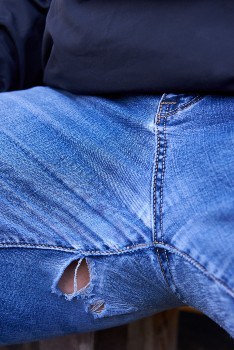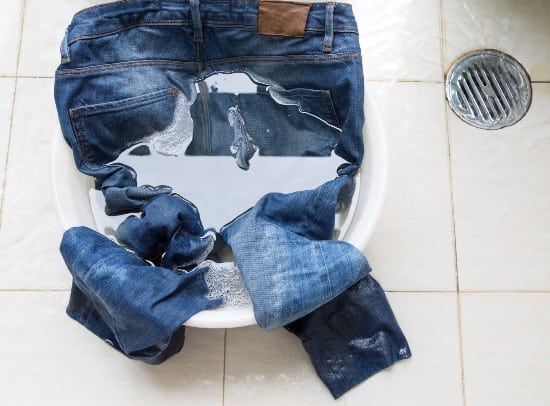I have noticed that when it comes to wearing ripped jeans, there needs to be a balance. The right amount of tearing can make your jeans look deliberately edgy and stylish. Too much ripping, however, and your jeans will inevitably look sloppy and on the verge of falling apart.
When rips in jeans go too far, they can easily be fixed by ironing on a fabric patch, stabilizing the opening of the hole with fabric glue or stitching, or even covering the hole with hand embroidery. Further ripping can be prevented through careful handling and washing of the fabric.
In this article, I’ll give you my top tricks for how to fix ripped jeans that ripped too much. I’ll cover both sewn and no-sew options, so you’re sure to find a method that works for you. Follow these tips and your favorite jeans will last you for years.

Quick Navigation
Can Ripped Jeans Be Repaired?
Most ripped jeans can be repaired if you address the problem quickly and don’t allow the holes to grow any larger. You can typically fix small holes using iron-on fabrics, simple stitching, or even fabric glue.
The method you use to repair your jeans will depend on where the hole is located, its size, and your preferences regarding the final appearance of your clothing. Some of the methods I’ll discuss below will hide small tears completely. Others will embrace the ripping, choosing to highlight it with decorative stitching or carefully chosen fabrics in contrasting colors and patterns.
The only rips that may not be able to be repaired are those that are severe and cover a large area of the fabric. While it may be possible to fix large rips with careful stitching or patching, it can be difficult to disguise damage and the large patches may not hold. This is especially the case for large rips across the butt of your jeans.
Additionally, rips to the structural areas of your jeans may prove difficult to repair. This is especially the case for the waistline, zipper, and any buttonholes your jeans may have. In some cases, these rips may be so severe that it is better to replace the jeans altogether.
How to Fix Ripped Jeans That Ripped Too Much: 6 Methods

There are many different approaches you can take to fix your ripped jeans. Pay attention to which options work best for the size and location of the tears you are dealing with.
1. Disguise Holes With Matching Fabric
If you are dealing with small to medium-sized holes that you want to keep hidden, this method may be your best option. You can easily repair these tears by filling in the hole with a fabric that matches the exact color and texture of the denim of your jeans.
To do this, you will want to first find coordinating fabric. You can do this by sacrificing another pair of jeans or purchasing denim from your local fabric store. You’ll want to try to choose denim that is the same color, weight and has the same stretch as the original fabric of your jeans.
Once you’ve sourced the fabric, you can use it to patch the hole. Your repairs will be less noticeable if you apply the patch to the inside of the hole so that the fabric covers the tear from within. You can attach the patch to the inside of your jeans by stitching around its outer edge or using fabric glue.
You’ll want the patch to be a bit larger than the hole so that you can secure it at least ½” from the edges of the tear. If you place the patch too close to the edge, you risk the hole tearing further and the edges of the patch lifting away.
You’ll want to finish the repair by carefully cleaning up the edges of the hole by cutting away loose threads. You can seal the edges with fabric glue to prevent further tearing.
2. Add an Iron-On Patch
Iron-on patches are a convenient option if you don’t want to sew the holes in your jeans. They come in a variety of colors and patterns, which can range from colors of denim that exactly match your pants to contrasting patterns that will add a pop of color. Which you choose will depend on your own design preferences.
Before you add the patch, you’ll want to first clean up the hole. Cut away any loose threads, and seal the edges with fabric glue. As you do this, you can have your iron on standby to allow it to heat to the temperature specified by the patch you purchase.
Once your iron is at the correct temperature, place the patch over the hole outside your jeans. You’ll want to place a barrier behind the hole to keep the adhesive from the patch from poking through and sticking to another area of the jeans. Then, apply heat to the patch according to the directions on the packaging – usually 30 to 45 seconds.
You’ll want to keep the iron moving to apply even heat and pressure. Run your finger along the outer edge of the patch to ensure it has fully adhered before allowing it to cool completely. This cooling time is critical to allowing the patch to be fully set.
Keep in mind that the edges of the iron-on patch can catch, meaning that this repair may not work well on the inner thighs of your jeans. This technique will work best in areas that don’t receive a lot of friction.
3. Sew Decorative Fabric Behind the Rip
It’s not always possible to exactly match the fabric of your jeans with either a denim patch or an iron-on covering. In these cases, you can fully embrace the tears by highlighting them with a contrasting fabric!
Simply choose a fabric design and color you like, which can be cut to make a patch. You’ll want to be sure that your patch is larger than the hole by ½” on all sides to allow it to adhere properly. You can use any fabric you’d like, though you should always remember that delicate fabrics can easily tear and thick fabrics can make the repairs bulky and uncomfortable.
You should also keep in mind that any colors you choose will be permanent and may not always match your outfits. If this is a concern, try to pick a neutral fabric that will work with other clothing options you have in your wardrobe.
Once you’ve chosen your fabric and cut your patch, you can stitch it on the inside of the hole. Be sure to use a thread that matches the denim of your jeans to keep your stitches hidden. You could also apply the patch with some fabric glue in a pinch.
If you prefer a clean look to the edges of the hole, you can finish the repair by removing any loose threads and sealing the tear with fabric glue. Otherwise, you can leave the loose threads in place since this type of repair is meant to draw attention to the rips.
This technique can be used for virtually any size of the hole. It will look the best when used on holes in the knees of your jeans, upper thighs, or pockets.
4. Stabilize the Opening with Stitches
Sometimes, you’ll find that you don’t mind the larger rips in your jeans – especially if they occur on the knees or upper thigh. In these cases, you can stabilize the edges of the hole to keep the tear at its current size. It won’t diminish the damage already done but won’t allow further damage.
You’ll need to stitch around the edges of the hole using a zigzag or overcast stitch on your sewing machine. A straight stitch will also work, though it won’t hold as well as the other options mentioned. Alternatively, you could also use a serger to clean up the edges of the hole, though this will cut away any loose threads.
With this method, you’ll want to use a thread that matches the color of your denim. This will allow your reinforcement to blend in with the fabric rather than stand out.
5. Hand Embroider a Fun Design
If you’re looking for a way to cover small holes while also adding your own flair to the jeans, this option is for you! You can easily repair small tears in your jeans by covering them with decorative embroidery in your choice of color and pattern.
To do this, choose an embroidery pattern large enough to cover the hole. You’ll want a design with stitches surrounding the entire perimeter of the tear to firmly anchor it in place and fully cover the area that needs fixing. Circular, floral, or star-shaped designs often work well to cover small tears, though you can get as creative and elaborate as you’d like.
You’ll need to purchase embroidery thread to use this method, which is thicker and heavier than ordinary sewing thread. You’ll also need an embroidery needle and may want to use an embroidery hoop to hold the fabric in place as you work.
You can add the embroidery to other areas of your jeans to make the portion covering the hole look like it is part of a larger design. If you’re feeling particularly creative, you can also add beading or sequins to your embroidery. This is a fun way to add some extra flair, making the tears in your jeans look deliberate and stylish.
6. Reinforce Fraying Denim with Interfacing
One of the best ways to repair rips in your jeans is by stopping the tears before they grow too large. If you can spot fraying areas of your jeans before they fully rip open, you can reinforce the weakened fabric using interfacing.
This option works best on areas of your jeans that haven’t fully ripped since the interfacing will be visible through any holes. It tends to be white, standing out brightly against the darker denim fabric. If your jeans have fully ripped through, you’ll likely want to use one of the other options mentioned above.
Interfacing comes in both sew-in and iron-on options and a variety of thicknesses. Iron-on options will easily reinforce fraying jeans and will simply require you to cut a piece of interfacing to cover the area. Then, you’ll iron it in place following the instructions on the packaging.
You’ll want to be sure to prepare your interfacing before you apply it to prevent it from pulling or shrinking. Iron-on interfacing can be prepared by submerging it in warm water before allowing it to air dry. Sew-in interfacing can be pre-washed and dried in your regular laundry cycle.
How to Stop Jeans From Ripping Between Thighs
 It’s incredibly common for jeans to rip between the thighs since this area experiences a lot of friction from your legs rubbing together as you walk. While this fraying may be inevitable, there are steps you can take to slow the process down.
It’s incredibly common for jeans to rip between the thighs since this area experiences a lot of friction from your legs rubbing together as you walk. While this fraying may be inevitable, there are steps you can take to slow the process down.
You’ll want to take care of your denim from the start. Try not to wash the jeans excessively, and consider using a laundry detergent designed for denim. You’ll want to avoid hot water and dry the jeans with heat since the high temperatures can weaken and shrink the denim fibers over time.
You can also help slow ripping by spacing out how often you wear your jeans. Your favorite pair will last longer if you rotate it out with other options throughout the week. Stock up on designs you like, and give them a break when you can.
If you know your jeans tend to rip between the thighs, you should also take steps to reinforce the area. You can apply denim iron-on patches on the inside of the thighs immediately after purchase to make it harder for the area to fray. Alternatively, you could add interfacing to the problem areas to give the fibers added strength.
Can You Fix Ripped Pants Without Sewing?
Yes, there are several ways to fix ripped pants without sewing. There are many iron-on products currently on the market, as well as fabric glues that can seal and reinforce worn areas.
Iron-on patches are the easiest way to fix ripped pants without sewing since they can be applied in minutes with heat. You can choose a patch that closely matches the color of your pants or can choose a contrasting pattern that adds a pop of color. Simply cut the patch to size and follow the instructions on its packaging to properly apply heat with your iron.
Fabric glue is also a quick and easy way to fix pants. You can use it to seal the edges of a hole, keeping it from growing in size. You can also use it to adhere fabric to the inside of the hole, covering it altogether. Fabric glue will work with most fabrics.
How to Stop Distressed Jeans From Ripping More
Preventing your jeans from ripping more starts when you put them on. One common source of ripping is accidentally putting your foot or toes through a hole as you get dressed. Jewelry can also catch on ripped areas of the jeans as you handle them, so take care to remove rings and other potential hazards before you dress for the day.
As you wear your distressed jeans, pay attention to your surroundings. You can easily rip the jeans further by catching them on the edge of furniture or other sharp objects you happen to bump into. Only wear your distressed jeans on days when your activities aren’t too strenuous since too much movement can also rip the jeans further.
If you feel like the holes of your jeans are on the verge of ripping further, you can reinforce the edges with some fabric glue or superglue. Simply run a line of glue along the edges of the opening, which will seal the ends of the fibers. You’ll want to be careful not to apply too much glue, as it can darken the fabric or make it stiff to the touch.
How to Wash Ripped Jeans Without Ripping More

Since ripped jeans already have holes, you’ll want to treat them gently during the washing cycle. You can certainly hand wash your jeans using cold water, careful not to pull on the ripped areas. Regular laundry detergents are safe, but you’ll want to avoid harsh chemicals like bleach.
If you’re like me, however, you probably want the convenience of being able to use your home washing machine. In that case, you can protect your ripped jeans by washing them on the gentlest cycle the machine has. You’ll want to use only cold water since warmer temperatures can cause the denim fibers to constrict and tear the holes even wider.
You should avoid washing the jeans with anything that could snag on the holes. This includes any clothing with metal clasps, metal buttons, or other pieces of hardware that can tear your jeans further. You can further reduce the chances of this by washing your jeans in a lingerie bag.
Drying your jeans with heat can also cause the fibers to contract, ripping them further. Instead, allow your jeans to air dry. Do not wring the jeans out, as this pulling can cause further damage.
Any washing can lead to further ripping, so be careful to only wash your jeans when necessary. Avoid staining or otherwise dirtying your delicate jeans as much as possible. Most jeans can be worn multiple times between washes since the fabric was originally meant for daily wear while working.
Conclusion
Distressed jeans are a stylish and edgy addition to any wardrobe, and you shouldn’t have to worry about rips growing too large. Keep this guide handy, so you’ll always have the tips you need to handle any necessary repairs that come your way.